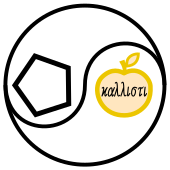Discordianism
Discordianism (from Latin : discordia "discord") and variants derived from it such as the Church of the SubGenius have been widespread religions since the 1980s as a result of neo-pagan currents. Allegedly, Discordianism was invented in 1957. The authoritative text was probably created anonymously from 1979 and published as the so-called Principia Discordia , citing the American author Robert Anton Wilson and his novel Illuminatus! (1975). Discordians are people there who are fighting against the supremacy of the Illuminati . Initially cultivated as a fan culture, Discordianism has become a religion of its own.
Content
There is no fixed content of Discordianism. The information on years, persons and groups published on websites and in books is fictitious. A relatively constant trait is disregard for authority and coercion. Wilson named all those who listened to his lectures as “Discordian Popes”. Discordians dispute objective truths. They love contradictions, because they show the limits of logic. In order to deal with contradictions, one must overcome the usual logical thinking and give the mind new freedoms. Someone who railed against disorder and suppressed the fact that there is creativity in the disorder is often referred to as a gray face or aneristic .
Sacred Chao
The Sacred Chao (sacred Chao) is a symbol of Discordianism. The word chao is said to stand for the singular form of chaos; the pronunciation is the same as the English word cow , a playful reference to the American-English exclamation "Holy cow!" (holy cow). The Pentagon represents the law of the five and stands for authority and order; the golden apple of contention of the Eris , with which they started the Trojan War, stands for creativity, chaos and discord.
Law of Five
The Discordian Law of Five says that everything that happens in the universe is related in some way or form to the number five or a multiple of five. For example, the often mentioned twenty-three is a part of the law of five, because 2 + 3 = 5. As with 23, it is possible that people who deal with the law of five are conditioned to perceive the number five and thus think to see this number more often than before.
The Pentabarf (the five commandments)
According to the Principia Discordia, the Pentabarf ( Penta gr. "Five", barf English "puke") was "found carved in a golden stone by the Apostle Zarathud" and illustrates the Discordians' preference for the paradox :
- There is no goddess but the goddess, and she is your goddess. There is no Erisian Movement but the Erisian Movement, and it is the Erisian Movement. And every golden apple is the beloved home of a golden worm.
- A Discordian should always use the official Discordian document numbering system.
- At the beginning of his illumination , a Discordian is obliged to go outside alone on a Friday to happily enjoy a hot dog ; This ceremony is there to demonstrate against the popular paganities of these days: against Catholic Christianity (no meat on Fridays), Judaism and Islam (no pork), Hinduism (no meat from the cow), Buddhism (no meat from animals) and Discordianism (no hot dog rolls).
- A Discordian should not eat hot dog buns, as these were the goddess' consolation when she faced the original rejection.
- A Discordian is forbidden to believe what he is reading.
calendar
In the Discordian calendar , the year consists of five seasons (chaos, discord, confusion, bureaucracy and the aftermath), the week consists of five days of the week (Sweetmorn, Boomtime, Pungenday, Prickle-Prickle and Setting Orange), and there are 2 × 5 holidays ( Holydays ). The current Discordian date can be displayed in many Linux distributions by entering " ddate ".
Tarot
There are also drafts for a “free” tarot set consisting of 73 cards ( 23 trumps and 5 number and 5 theme cards for each of the 5 Discordian elements) that takes up the Discordian Dada mysticism. There is currently no printed version of it.
See also
literature
- Malaclypse the Younger: Principia Discordia. ISBN 3-9333-2120-4 .
- Robert Shea, Robert A. Wilson: Iluminatus - The eye in the pyramid. ISBN 3-499-24272-9 .
- Robert Shea, Robert A. Wilson: Iluminatus - The golden apple. ISBN 3-499-24273-7 .
- Robert Shea, Robert A. Wilson: Iluminatus - Leviathan. ISBN 3-499-24274-5 .
- Robert Anton Wilson : The Illuminati Papers ISBN 978-3-499-15191-0 .
- Robert A. Wilson: Cosmic Trigger - The final mystery of the Illuminati or at the limits of expanded consciousness . Rowohlt, Reinbek near Hamburg 1985, ISBN 978-3-499-15649-6
Web links
- Book text Principia Discordia (English)
- POEE - The Living Encyclopedia Chaotic ( Memento from May 20, 2009 in the Internet Archive ) (English)
- Principia-Discordia.de - German-language Principia Discordia website ( Memento from May 4, 2010 in the Internet Archive )
Individual evidence
- ↑ David Chidester: Authentic Fakes: Religion and American Popular Culture . University of California Press, March 19, 2005, ISBN 978-0-520-93824-3 , pp. 198-199.
- ^ Carole Cusack, Alex Norman: Handbook of New Religions and Cultural Production . BRILL, March 28, 2012, ISBN 90-04-22187-5 , p. 421.
- ↑ Discordian Deck (English; PDF; 674 kB)

